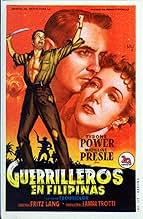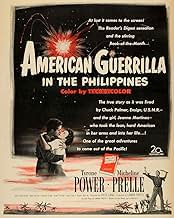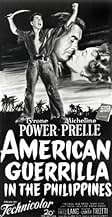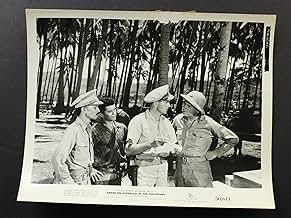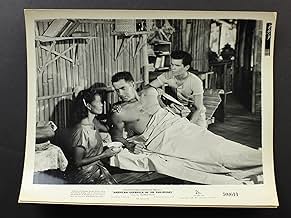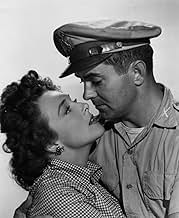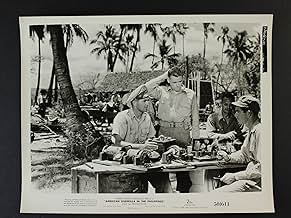IMDb RATING
5.9/10
1.4K
YOUR RATING
American soldiers stranded in the Philippines after the Japanese invasion form guerrilla bands to fight back.American soldiers stranded in the Philippines after the Japanese invasion form guerrilla bands to fight back.American soldiers stranded in the Philippines after the Japanese invasion form guerrilla bands to fight back.
Micheline Presle
- Jeanne Martinez
- (as Micheline Prelle)
Robert Patten
- Lovejoy
- (as Bob Patten)
Miguel Anzures
- Native Traitor
- (uncredited)
Sabu Camacho
- Bo
- (uncredited)
Erlinda Cortes
- Partisan
- (uncredited)
Cris de Vera
- Japanese Officer
- (uncredited)
Rosa Del Rosario
- Partisan
- (uncredited)
Maria del Val
- Señora Martinez - the Aunt
- (uncredited)
Vic Diaz
- Japanese General
- (uncredited)
Arling Gonzales
- Radio Operator
- (uncredited)
Fred Gonzales
- Radio Operator
- (uncredited)
Eddie Infante
- Col. Dimalanta
- (uncredited)
- Director
- Writers
- All cast & crew
- Production, box office & more at IMDbPro
Featured reviews
This is a seldom referenced and very overlooked old movie, but Fritz Lang still shows what an amazing filmmaker he is here. The script is good (not great) but the direction and some surprisingly good acting turn this one into a real winner. Definitely worth watching.
Not a bad movie, really. Colorful, exotic locations, educational, some interesting combat scenes. But coming from the director of "Metropolis" and "M"?
It reminds me of an anecdote told by the psychologist who wrote "The Three Christs of Ypsilanti." That's a psychiatric hospital in Michigan. Three patients claimed to be Jesus Christ. The psychologist was watching a film with the one named Louie. Adlai Stevenson, then Governor of Illinois, appeared on the screen. "That's me," cried Louie, "I'm Adlai Stevenson." The psychologist replied, "I thought you were Jesus Christ." "I am," said Louie, "I'm Jesus Christ too -- but I've got to make a living."
Fritz Lang must have had some similar motive for making this rather routine war film. It has every cliché in the book. The romance thrown into the middle of the muddle. The cavalry riding to the rescue at the last possible moment. The acting of the principals is at par, but some of the bits are played by people who seem to have had no training in inducing a suspension of audience disbelief.
The best scene in the film has Tom Ewell (in an uncommonly dramatic part) trying to hide from the Japanese under a rotting log. His bare feet are on an ant hill and soon his skin is crawling with stinging ants while he bites his tongue and prays.
The best performance is given by the Japanese officer. He's great. Sinewy, dapper, ruthless, ironic. Speaking to Michelline Presle, who has been aiding the guerrillas -- "You rike Americans with WHITE FACES, like boiled pork." Marvelous line. (That bleached skin, like blue eyes, is an evolutionary anomaly confined to northwestern Europe.) The guy is fascinating to watch physically, in the way that Jack Palance is.
Minor error. Ty Power and Tom Ewell are reporting on the position and movements of two Japanese destroyers (actually, they look like Geary-class American ships). Power gives the info on the ships to Ewell next to him, who relays it by phone to a radio operator who encodes and transmits it. But the operator isn't sending information on the location of the ships. He keeps sending the word "news" over and over, interspersed with a couple of letter "b"s.
It is not, as I say, a bad movie. It's just done rather by the numbers. A far better job dealing with our defeat in the Phillipines was done by John Ford in "They Were Expendable." This film is worth watching as a description of the very real guerrilla movement that developed in the Islands after that initial defeat.
It reminds me of an anecdote told by the psychologist who wrote "The Three Christs of Ypsilanti." That's a psychiatric hospital in Michigan. Three patients claimed to be Jesus Christ. The psychologist was watching a film with the one named Louie. Adlai Stevenson, then Governor of Illinois, appeared on the screen. "That's me," cried Louie, "I'm Adlai Stevenson." The psychologist replied, "I thought you were Jesus Christ." "I am," said Louie, "I'm Jesus Christ too -- but I've got to make a living."
Fritz Lang must have had some similar motive for making this rather routine war film. It has every cliché in the book. The romance thrown into the middle of the muddle. The cavalry riding to the rescue at the last possible moment. The acting of the principals is at par, but some of the bits are played by people who seem to have had no training in inducing a suspension of audience disbelief.
The best scene in the film has Tom Ewell (in an uncommonly dramatic part) trying to hide from the Japanese under a rotting log. His bare feet are on an ant hill and soon his skin is crawling with stinging ants while he bites his tongue and prays.
The best performance is given by the Japanese officer. He's great. Sinewy, dapper, ruthless, ironic. Speaking to Michelline Presle, who has been aiding the guerrillas -- "You rike Americans with WHITE FACES, like boiled pork." Marvelous line. (That bleached skin, like blue eyes, is an evolutionary anomaly confined to northwestern Europe.) The guy is fascinating to watch physically, in the way that Jack Palance is.
Minor error. Ty Power and Tom Ewell are reporting on the position and movements of two Japanese destroyers (actually, they look like Geary-class American ships). Power gives the info on the ships to Ewell next to him, who relays it by phone to a radio operator who encodes and transmits it. But the operator isn't sending information on the location of the ships. He keeps sending the word "news" over and over, interspersed with a couple of letter "b"s.
It is not, as I say, a bad movie. It's just done rather by the numbers. A far better job dealing with our defeat in the Phillipines was done by John Ford in "They Were Expendable." This film is worth watching as a description of the very real guerrilla movement that developed in the Islands after that initial defeat.
There were hundreds of these cheap-ish World War Two quickies in the decade following the close of the conflict itself. They differed little from those produced during the war, still being in a kind of adulatory propagandistic mode, except that they were a little more vague usually having no direct message. What's more, as more time went by the seemed to get further and further from the realities of the conflict.
An American Guerrilla in the Philippines sees Tyrone Power, swashbuckling idol of the pre-war years, as an officer battling Japs in the Philippine jungle. Power has matured as an actor since his pictures a decade earlier, appearing tougher and less boyish, although he has also become less interesting in the process. His performance is steady and natural, but he is unable to make anything of what is admittedly a rather bland character on paper anyway. His buddy Tom Ewell is an unusual addition to the cast. He was in later years a very fine comedy actor, but it's hard to tell if he's appearing here as comic relief or not. In some moments, such as his burbling in the water trying to stay afloat, seem as if he is trying to play them for laughs, inappropriately if so, and certainly not at all funny. The rest of the cast is simply plain bad or plain boring.
Director Fritz Lang is normally someone who can give a nice baroque touch to even the most American of film formats, while still remain true to genre and tone. He seems uncertain however quite what to do with this one. He gives many shots in the jungle an abstract feel, with no familiar points of reference, giving them a threateningly wild look. Often his camera takes a spectator's position, peeping out through foliage. It's hard to tell what purpose this serves, as it distances us from the events on screen. Incidentally, Lang was a very good director of crowds and action, as evidenced in his big-budget silent pictures. There are some very powerful moments, with characters moving straight towards us down the middle of the shot and memorably stylised movements. However for a director who is normally so good at imbuing his work with a dark and nightmarish feel, An American Guerrilla in the Philippines has none of the bleak terror of, say, Operation Burma, a picture which really worked because it made us the audience feel lost within the jungle ourselves.
And ultimately An American Guerrilla in the Philippines is too light, and too sparing on any true sense of tragedy. It's lack of a real feeling of danger gives it many dull stretches, and its lack of realism does a disservice to those involved in the conflict. All of which is rather odd because the picture is also far from being a comedy. The only thing which saves it and makes it watchable is Fritz Lang's strong, vibrant imagery, such as dozens of hats waving in the air or a soldier's dying scream just inches from the lens. Having said that, there are far better Fritz Lang pictures to see these brilliant touches in.
An American Guerrilla in the Philippines sees Tyrone Power, swashbuckling idol of the pre-war years, as an officer battling Japs in the Philippine jungle. Power has matured as an actor since his pictures a decade earlier, appearing tougher and less boyish, although he has also become less interesting in the process. His performance is steady and natural, but he is unable to make anything of what is admittedly a rather bland character on paper anyway. His buddy Tom Ewell is an unusual addition to the cast. He was in later years a very fine comedy actor, but it's hard to tell if he's appearing here as comic relief or not. In some moments, such as his burbling in the water trying to stay afloat, seem as if he is trying to play them for laughs, inappropriately if so, and certainly not at all funny. The rest of the cast is simply plain bad or plain boring.
Director Fritz Lang is normally someone who can give a nice baroque touch to even the most American of film formats, while still remain true to genre and tone. He seems uncertain however quite what to do with this one. He gives many shots in the jungle an abstract feel, with no familiar points of reference, giving them a threateningly wild look. Often his camera takes a spectator's position, peeping out through foliage. It's hard to tell what purpose this serves, as it distances us from the events on screen. Incidentally, Lang was a very good director of crowds and action, as evidenced in his big-budget silent pictures. There are some very powerful moments, with characters moving straight towards us down the middle of the shot and memorably stylised movements. However for a director who is normally so good at imbuing his work with a dark and nightmarish feel, An American Guerrilla in the Philippines has none of the bleak terror of, say, Operation Burma, a picture which really worked because it made us the audience feel lost within the jungle ourselves.
And ultimately An American Guerrilla in the Philippines is too light, and too sparing on any true sense of tragedy. It's lack of a real feeling of danger gives it many dull stretches, and its lack of realism does a disservice to those involved in the conflict. All of which is rather odd because the picture is also far from being a comedy. The only thing which saves it and makes it watchable is Fritz Lang's strong, vibrant imagery, such as dozens of hats waving in the air or a soldier's dying scream just inches from the lens. Having said that, there are far better Fritz Lang pictures to see these brilliant touches in.
A rugged war-time combat drama set in 1942 , focusing the actual story of a group of American soldiers in the Philippines who fought with the resistance movement . Classical and true warfare movie titled ¨American Guerrilla in the Philippines¨ , this British title obviously didn't approve of such American jingoist title : ¨I shall Return¨. It stars the great Tyrone Power in the lead and the flick talks about the Phillipines battle , during WWII , concerning on defenders and resistance fighters , but Japan has just invaded ; regarding events happened in Bataan , Corregidor and Leyte .The Japanese army has overrun the Philippines , sending General MacArthur packing , promising to return . The US Army's defense of its Philippines colony and the allied Malay countries/colonies behind it counted on its island fortress of Corregidor on Luzon -and a few others- but loses it in the 6 May 1942 Japanese combined forces attack . Exciting warfare movie following the blockade run that took General Douglas MacArthur and his staff from the Philippines to the safety of Australia , then the survivors of a bombed and sunk PT boat make their way to shore . Ensign Chuck Palmer (Tyrone Power) and crewman Jim Mitchell (Tom Ewell) finally reach Tacloban on the island of Leyte attempting to make Australia by a boat . In a Yankee mission school , Palmer meets the married women Jeanne Martinez (Micheline Presle) and , subsequently , both of whom fall in love . Later on , they are among the escaping survivors who are ordered by general Douglas McArthur to organize a guerrilla , as Chuck forms a guerrilla army to raid Japanese and to help Americans landing on Leyte . As a group of soldiers flee from Japanese repeatedly attack and they head for blowing-up the Japanese installations . The defenders gave a few days for posterior victories and future US conquest like Midway , Island Salomon and Bismark .
This classic warlike movie is nicely starred by Tyrone Power at one of his best and unknown roles as a two-fisted officer , he's accompanied by a plethora of first-rate secondaries , all of them form the small army of Guerrilleros endeavoring to blow up pivotal Japanese headquarters . Stirring actioner warfare completed with slice of military stereotypes although some characters are very one-dimensional . This rousing action saga results to be a a good film dealing with war in human terms . Here director Lang has a sensitive handling of actors and provides an exact compositional sense . Fritz handles in all -especially the battle scenes- with flair play and vigour . There is a fair bit of flag-waving and patriotism , but that was just what was needed when the picture was made . It may not be an awesome film , but this is a thrilling and well made war epic . This colorful movie contains action , breathtaking battles , thrills , historical events , romance , and the battle scenes are impressively made with special mention at the end as they are besieged at a church . Stalwart main cast , Tyrone Power , the French Michellie Presle , both of whom provide splendid interpretations . Being stunningly supported by Tom Ewell giving an eye-catching and sympathetic portrayal , Robert Patten, Tommy Cook , Vic Diaz , Carleton Young , uncredited cameo by Robert Barrat as Gen. Douglas MacArthur and Jack Elam as a grizzled swindler .
This is one of a handful of feature films that have featured the story of the World War II , Philippines surrending and Battle of Bataan , they include as follows : ¨Bataan¨ (1943) by Tay Garnett with Robert Taylor , ¨So proudly we hail ¡¨ by Mark Sandrich (1943) , ¨They were expendable¨ (1945) by John Ford with John Wayne , ¨Back to Bataan¨(1945) by Edward Dmytryck with John Wayne , Anthony Quinn , Beulah Bondi . The film is set into a lush , abundant jungle with nice cinematography in technicolor , though a perfect remastering being extremely necessary . It contains an atmospheric as well as evocative musical score by Cyril J. Mockridge . It is well set in South Pacific , Philippines and shot on location in Manila, Subic Bay, Philippines. The motion picturewas professionally directed by Fritz Lang but far from his classics , being a strange stuff to come from this German ex-patriate filmmaker. He is a prestigious director , his films deal with a deep description of civilized societies , he believes that corruption is an essential part of it , that society punishes sincerity , innocence and love, vengeance and greed determine the behavior of people . Rating : 6.5/10. The picture is pretty well , it is a spectacular picture but resulting to be sometimes a vaguely dull war Hollywood production .
The actual deeds deal with Philippines fall , creation of Guerrillas ,and concerning an unsuccessful attempt by US and Filipino troops under General Douglas MacArthur to defend the peninsular against the Japanese 1 Jan-9 April 1942 . Following the surrender of Bataan , MacArthur was evacuated , but Allies captives were force-marched 95 km/60 mi to the nearest railhead in the Bataan Death March,i ll-treatment by the Japanese guards during the march killed about 16.000 US and Filipino troops .
This classic warlike movie is nicely starred by Tyrone Power at one of his best and unknown roles as a two-fisted officer , he's accompanied by a plethora of first-rate secondaries , all of them form the small army of Guerrilleros endeavoring to blow up pivotal Japanese headquarters . Stirring actioner warfare completed with slice of military stereotypes although some characters are very one-dimensional . This rousing action saga results to be a a good film dealing with war in human terms . Here director Lang has a sensitive handling of actors and provides an exact compositional sense . Fritz handles in all -especially the battle scenes- with flair play and vigour . There is a fair bit of flag-waving and patriotism , but that was just what was needed when the picture was made . It may not be an awesome film , but this is a thrilling and well made war epic . This colorful movie contains action , breathtaking battles , thrills , historical events , romance , and the battle scenes are impressively made with special mention at the end as they are besieged at a church . Stalwart main cast , Tyrone Power , the French Michellie Presle , both of whom provide splendid interpretations . Being stunningly supported by Tom Ewell giving an eye-catching and sympathetic portrayal , Robert Patten, Tommy Cook , Vic Diaz , Carleton Young , uncredited cameo by Robert Barrat as Gen. Douglas MacArthur and Jack Elam as a grizzled swindler .
This is one of a handful of feature films that have featured the story of the World War II , Philippines surrending and Battle of Bataan , they include as follows : ¨Bataan¨ (1943) by Tay Garnett with Robert Taylor , ¨So proudly we hail ¡¨ by Mark Sandrich (1943) , ¨They were expendable¨ (1945) by John Ford with John Wayne , ¨Back to Bataan¨(1945) by Edward Dmytryck with John Wayne , Anthony Quinn , Beulah Bondi . The film is set into a lush , abundant jungle with nice cinematography in technicolor , though a perfect remastering being extremely necessary . It contains an atmospheric as well as evocative musical score by Cyril J. Mockridge . It is well set in South Pacific , Philippines and shot on location in Manila, Subic Bay, Philippines. The motion picturewas professionally directed by Fritz Lang but far from his classics , being a strange stuff to come from this German ex-patriate filmmaker. He is a prestigious director , his films deal with a deep description of civilized societies , he believes that corruption is an essential part of it , that society punishes sincerity , innocence and love, vengeance and greed determine the behavior of people . Rating : 6.5/10. The picture is pretty well , it is a spectacular picture but resulting to be sometimes a vaguely dull war Hollywood production .
The actual deeds deal with Philippines fall , creation of Guerrillas ,and concerning an unsuccessful attempt by US and Filipino troops under General Douglas MacArthur to defend the peninsular against the Japanese 1 Jan-9 April 1942 . Following the surrender of Bataan , MacArthur was evacuated , but Allies captives were force-marched 95 km/60 mi to the nearest railhead in the Bataan Death March,i ll-treatment by the Japanese guards during the march killed about 16.000 US and Filipino troops .
It's not really about what I thought of the film - I note military and naval experts have commented on various inaccuracies. This is more a comment on an aspect of the film, which I saw many years ago in b/w, and got a greater insight into when seeing the Canadian commentator Elwy Yost's programmes on cinema history in the 1970's. How many viewers realise that the reason the heroine (the Filipino hero's wife) is cast as a Frenchwoman? This is not to make the story more romantic, or as a tribute to 'our gallant wartime allies' or even because the actress might be French, but because in those days to comply with the Hayes Code, the heroine, if she gets the white hero in the end (or vice versa!) has to be white!
Did you know
- TriviaThis movie was filmed just prior to the outbreak of the Korean War in June of 1950, and used American warships to portray Japanese ships. One such ship, the U.S.S. Orleck (DD 886), exists to this day after serving in the Korean War, the Vietnam War and being sold for a while to the Turkish Navy, and is permanently docked in Lake Charles, LA, where it serves as a museum.
- GoofsWhen setting the sail early in the movie, Power's character refers to a halyard as a sheet. No real sailor would make such an error.
- ConnectionsEdited into La guerre, la musique, Hollywood et nous... (1976)
- How long is American Guerrilla in the Philippines?Powered by Alexa
Details
- Release date
- Country of origin
- Languages
- Also known as
- American Guerrilla in the Philippines
- Filming locations
- Production company
- See more company credits at IMDbPro
- Runtime1 hour 45 minutes
- Aspect ratio
- 1.37 : 1
Contribute to this page
Suggest an edit or add missing content

